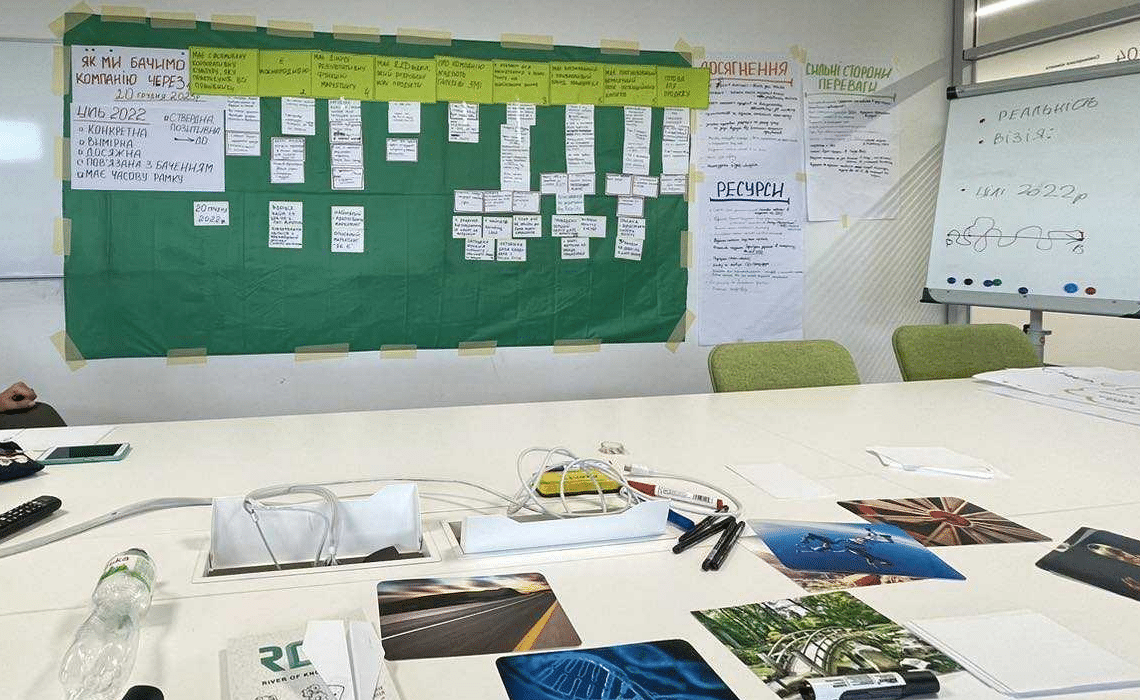Agenda-Powered Strategy Sessions: Unlocking Success with Our Template

Boost your strategy sessions with our proven agenda template. Learn how structured discussions can unlock unprecedented success in your business. Start streamlining your meetings today!

Join 2000+ tech leaders
A digest from our CEO on technology, talent and hard truth. Get it straight to your inbox every two weeks.
No SPAM. Unsubscribe anytime.
In today’s fast-paced business environment, you need to have a clear strategic plan that can guide your organization toward success. A powerful strategic planning session can help your leadership team in various ways. They can identify key strategic priorities, initiatives, and action plans to lead to long-term growth and prosperity. However, a strategy session can quickly become disorganized and ineffective without a well-structured agenda.
That’s why we’ve developed our strategy session template, which can help you unlock success in your workshop sessions. It also ensures your team is aligned and focused on achieving your organization’s strategic objectives.
But first, let’s start with the definition.
What is a strategy session?
A strategy session is a focused meeting where individuals or teams discuss, develop, and refine goals, plans, and actions to achieve specific objectives. These sessions encourage collaboration, creative problem-solving, and effective decision-making, often involving analyzing current situations, identifying opportunities, and formulating clear, actionable strategies to drive success.
Typical plan (agenda) for a one-day strategy session at Echo
A well-crafted agenda helps us align our vision, prioritize efforts, and achieve strategic objectives promptly and effectively. So let’s take a closer look at a day’s plan on how to run strategic planning meetings properly.
1. Welcome and Rules Setting (10:00 AM – 10:30 AM)
- Welcome participants;
- Present an overview of the current situation or challenge;
- Share the purpose and desired outcomes of the strategy session;
- Set rules.
2. ARA Analysis (10:30 AM – 11:30 AM)
- Identify the achievements, resources, and advantages of our company;
- Encourage participants to share their perspectives and insights.
3. Break (11:30 AM – 11:45 AM)
4. Strategy Development (11:45 AM – 1:00 PM)
- Break into smaller groups or work as a whole to brainstorm potential strategies and tactics;
- Encourage creative thinking and open dialogue;
- Set a timeframe of how “far” do you plan your future for.
5. Lunch (1:00 PM – 2:00 PM)
- Enjoy a meal together and use the time for informal discussions and networking
6. Strategy Refinement and Prioritization (2:00 PM – 3:30 PM)
- Review the brainstormed strategies and refine them as needed;
- Prioritize strategies based on impact, feasibility, and resources required.
7. Break (3:30 PM – 3:45 PM)
8. Action Planning and Goal Setting (3:45 PM – 5:30 PM)
- Develop detailed plans for the prioritized strategies, including tasks, responsibilities, and timelines;
- Establish clear, specific, and measurable goals for the project or initiative;
- Discuss the timeline and resources needed to achieve the goals.
9. Break (5:30 PM – 5:45 PM)
10. Commitment and Accountability (5:45 PM – 6:00 PM)
- Review action plans and confirm participants’ commitment to their assigned responsibilities;
- Establish methods for tracking progress, measuring success, and ensuring accountability.
11. Defining Obstacles (6:00 PM – 6:30 PM)
- Analyse potential challenges and solutions;
- Discuss the timeline and resources needed to achieve the goals.
12. Wrap-up and Next Steps (6:30 PM – 7:00 PM)
- Recap the day’s discussions and outcomes;
- Identify next steps, such as follow-up meetings or progress reports;
- Thank participants for their contributions and close the session.
We completed two strategy sessions last year following the agenda above and that’s what we learned:
10 Commandments for Efficient Meetings
The first thing we did was set some rules. Here’s the list we chose for our sessions:
- Take breaks every 2 hours.
- Do not interrupt your colleagues.
- Focus on a subject.
- Start on time.
- No cellphones.
- When one speaks, everyone else listens.
- Respect other opinions.
- Combine ideas.
- Do not criticize other people’s ideas.
- Compromise.
Establishing the foundation for proper behavior will help your company achieve top results. By ensuring that all team members adhere to a common set of guidelines, almost all issues can be effectively mitigated.
ARA Analysis
Widely known SWOT analysis is typically a part of almost any strategy session agenda. However, we had a suggestion from our facilitator Olha Sadokha to choose a different approach.
We started with the question “What are the achievements, resources, and advantages of our company?”.
“The most important things in your own life can be listed within three minutes.”
At Echo we are proud to share our findings:
Achievements
- Eight years as a successful business venture in the IT industry.
- A diversified customer portfolio.
- Well-written processes and procedures.
- Projected revenue.
- Positive reputation in the internal labor market.
- Long-term projects.
- Successful hiring in Eastern Europe, the Balkans and Turkey.
Resources
- Website with high traffic.
- Professional management team.
- Network of reliable partners.
- Experienced CEO.
- Equipment.
- Software.
Advantages
- Ambitious team that shares the same values.
- Loyal clients.
- Five-star ratings on resources like Clutch.
- Active on social media.
- Efficient marketing and SEO.
- High emotional intelligence among staff.
- Flexible business model.
- Remote work.
- Open-minded and ready for changes.
- Honesty with everyone.
Our achievements, resources, and advantages are the foundation of our company on which we will build our future. These are the things we can lean on. Knowing what you HAVE is crucial to see how to get what you want.
Strategy Development
Why is vision important in strategy development? We as human beings consume information and learn best through visual objects. We like pictures and imagine movie-like scenes while reading stories.
“A picture is worth a thousand words.”
To project our vision, we had to set a time frame. How far out do we plan our future? With war on our doorstep and economic uncertainty in the US and Europe, we used the strategy session to plan our growth until December next year, with semiannual revisions and amendments.
To make it more practical, we had to ask ourselves: “What does our company DO or HAVE in December XXXX?”
Don’t bother categorizing your thoughts; you can do this later. Just let your brain and imagination explore your ideas. Give yourself at least 60 minutes to brainstorm your future.
☝️ Insight: We used stickers for each idea. Having each idea on a separate sticker helped us move them to the category they belong in.
Here is a random and unsorted list of what we envision:
- Successful recruitment campaigns in the LATAM region.
- At least 20 long-term projects secured.
- A unique value proposition (UVL) is defined.
- Presentation of new candidates to clients within 5 days.
- The largest database of candidates from Eastern Europe.
- Recognition as a well-known company in Ukraine.
- The average client account has 10+ tech specialists.
- A well-documented sourcing process and procedures.
- Ranking among the top 10 best employers in the IT sector in Ukraine.
Strategy Refinement and Prioritization
The next important step was to categorize the big list we had on our table. It is common for two individuals to express a similar idea in different wording. Therefore we combined two ideas into one if there was a need. Here is an example of how we categorized the ideas mentioned above:
We are a role model in recruitment
- We successfully hire in the LATAM region.
- We present a new candidate to the client within five days of starting the recruitment campaign.
- We have the most extensive base of candidates from Eastern Europe in Ukraine.
- We have an established sourcing process and written procedures.
We have a well-known and positive reputation as an employer
- We are a well-known company in Ukraine.
- All our employees are loyal to our company.
- We are in the top 10 best employees in the IT sector in Ukraine within our category.
We have a predictable number of lead conversions per month
- Our average account has 10+ developers per project.
- We have at least 20 long-term projects.
- We have a unique value proposition.
When we finished naming categories, it was already time for a lunch break. It took quite a while to combine some ideas and choose how to name the categories. To be honest, we even had to quarrel and move ideas back and forth to find the best places for them.
☝️ Insight: We were not afraid to voice our opinions and to have a moderate fight with our colleagues. The truth lies in debates and interactions.
Having a vision written in carefully chosen words allows you to set SMART goals. We had to ask ourselves: HOW do we get where we want to be?
We categorized our visions, gave them names, and aligned our ideas under each category. What if you have ten categories or even more? Which ones are more important?
Each of our colleagues was given ten stickers to prioritize what is essential to our company. The task was to vote for which vision was most crucial to develop. You could have one sticker for each vision or ten for one vision. There are no rules except one – use your stickers wisely.
Action Planning and Goal Setting
With our priority identified, we could now move on to the next part of our strategic process and start setting SMART goals.
Let’s use recruitment at Echo as an example. We have decided that by December “We want to be a role model in recruitment”.
How do we get there? Here are some of our SMART goals:
- Present a new candidate to the client within five days of starting the recruitment campaign.
- Hire a lead recruiter to manage the team.
- Revise sourcing strategy and renew processes.
- Appoint a dedicated recruiter for the LATAM region.
- Migrate the old database to our new applicant tracking system.
☝️ Insight: We always appoint someone to be responsible for each goal. Collective responsibility is a disease you need to cure.
Commitment and Accountability
Why do commitment and accountability always appear in strategy session templates? Here are two simple answers we learned over the years:
- Collective responsibility leads to failure.
- Commitment and accountability increase the likelihood of successful implementation of a strategic plan, create a culture of responsibility, facilitate monitoring and evaluation, and encourage transparency and communication.
We knew from our past experience that this was an important step to take. The task seemed to be easy – just put a sticker with your name on it next to the tasks.
When faced with the responsibility of accomplishing a challenging objective, one may hesitate before committing to taking on the task. After a few minutes had passed, we came to the realization that all the tasks had been assigned.
Once we had finished placing our stickers, we were ready to discuss what would prevent us from reaching our strategic goals.
Defining Obstacles
It may seem like we were almost done with our collaborative session but we still had more work to do.
At the end of the brainstorming session, we were expecting to end up with a list of tasks but we wanted to define what or who could keep us from achieving our goals. Here is what we came up with:
- If there are toxic colleagues on our team – we part ways with them.
- If our team is sinking with daily tasks and has no time to progress towards our selected goals – we optimize our processes or hire new employees.
- If we have little experience in what we want to achieve – we will consult and learn from experts.
The list may go on and on, but the sooner you realize what is holding you back, the closer you can get to the goals.
Wrap-up and Next Steps
As our executive strategy session came to a close, we were all filled with a sense of accomplishment and excitement. Our heads were buzzing with ideas as we established our next steps before ending this successful meeting, which included:
- Adding our objectives to our internal HRM system.
- Scheduling monthly check-up meetings to monitor progress.
- Revising our goals in six months.
Finally, we took time to express our gratitude to all participants for their complete engagement, leaving all of us with a sense of inspiration and optimism toward achieving our goals.
Tags: agenda, brainstorming, efficiency, planning, productivity.



This is a fantastic step-by-step guide on how to run a strategy session. I particularly like how the day is broken down at the beginning of the article and then has examples of how each session is seen in real life. I think having rules that the whole group agrees on is important in being successful collaborators.